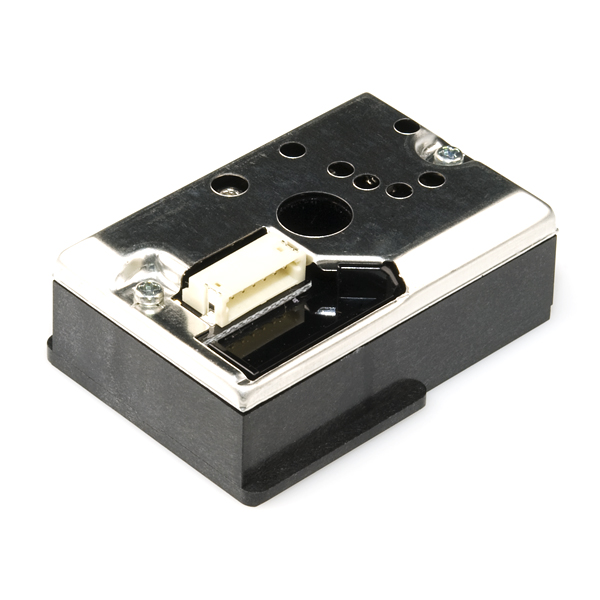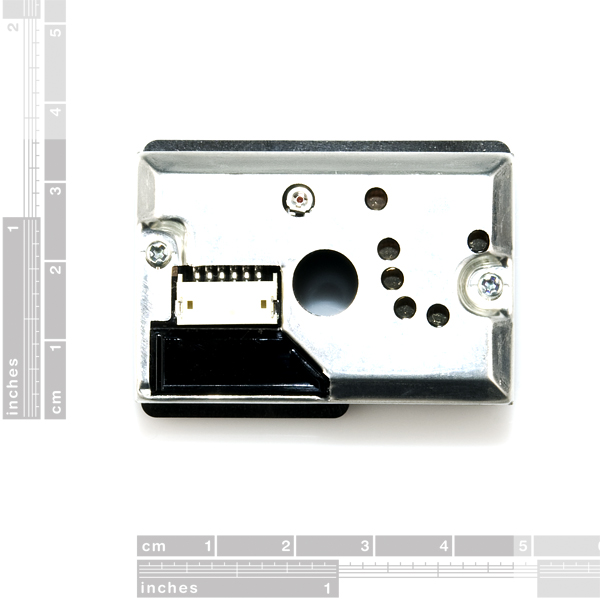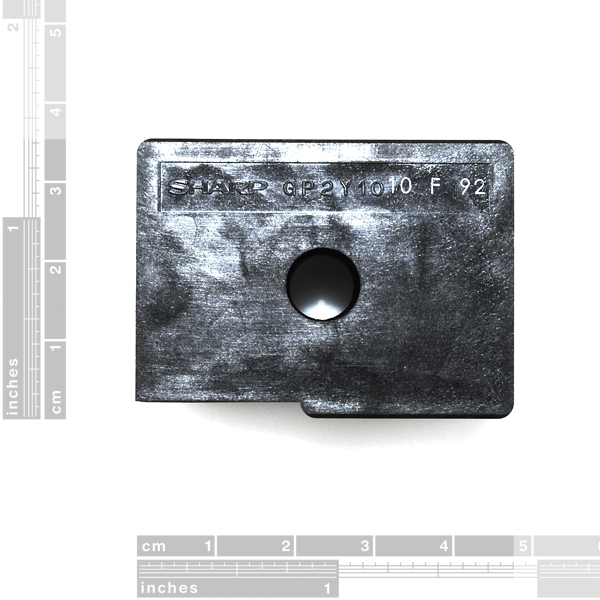Optical Dust Sensor - GP2Y1010AU0F
Sharp's GP2Y1010AU0F is an optical air quality sensor, designed to sense dust particles. An infrared emitting diode and a phototransistor are diagonally arranged into this device, to allow it to detect the reflected light of dust in air. It is especially effective in detecting very fine particles like cigarette smoke, and is commonly used in air purifier systems.
The sensor has a very low current consumption (20mA max, 11mA typical), and can be powered with up to 7VDC. The output of the sensor is an analog voltage proportional to the measured dust density, with a sensitivity of 0.5V/0.1mg/m3.
To interface with the sensor you need to connect to its 6-pin, 1.5mm pitch connector; we do have a mating connector for this.
- 1.81 x 1.18 x 0.69" (46.0 × 30.0 × 17.6 mm)
Optical Dust Sensor - GP2Y1010AU0F Product Help and Resources
2 of 2 found this helpful:
6 Pin Cable
This tutorial http://arduinodev.woofex.net/2012/12/01/standalone-sharp-dust-sensor/, provides a part number for the cable so you do not have to manually solder and crimp the pins into the housing for the sensor. You can go to Digi-Key and get part number #A100196-ND => http://www.digikey.lu/product-search/en?keywords=A100196-ND .
2 of 2 found this helpful:
Example Code, Tutorials, and Projects
There is some Arduino example code for the dust sensor here => https://github.com/PaulZC/GP2Y1010AU0F_Dust_Sensor .
Below is a list of tutorials and projects that use this sensor:
2 of 2 found this helpful:
Input Power Supply?
Looking at the datasheet, it looks like you can power the sensor anywhere around 0 to +7v. The example tutorials shown below indicate that you can power it at 3.3V or 5V. If you are using 3.3V Arduino (like an Arduino Fio), you should power the sensor at 3.3V so that the sensor output will match the logic levels. If you are using a 5V Arduino (like the RedBoard or Arduino UNO), you should power the sensor at 5V to match the logic levels.
Core Skill: Programming
If a board needs code or communicates somehow, you're going to need to know how to program or interface with it. The programming skill is all about communication and code.
Skill Level: Rookie - You will need a better fundamental understand of what code is, and how it works. You will be using beginner-level software and development tools like Arduino. You will be dealing directly with code, but numerous examples and libraries are available. Sensors or shields will communicate with serial or TTL.
See all skill levels
Core Skill: Electrical Prototyping
If it requires power, you need to know how much, what all the pins do, and how to hook it up. You may need to reference datasheets, schematics, and know the ins and outs of electronics.
Skill Level: Competent - You will be required to reference a datasheet or schematic to know how to use a component. Your knowledge of a datasheet will only require basic features like power requirements, pinouts, or communications type. Also, you may need a power supply that?s greater than 12V or more than 1A worth of current.
See all skill levels
Comments
Looking for answers to technical questions?
We welcome your comments and suggestions below. However, if you are looking for solutions to technical questions please see our Technical Assistance page.
Customer Reviews
2.5 out of 5
Based on 4 ratings:
2 of 2 found this helpful:
Connection is a problem
Works OK... except for actually connecting and using it.
Crimp some pins on some wires... shouldn't be a problem. Except: the pins are only 4mm long. The pieces that crimp the wire are 1mm long, and the crimp on the insulation is 0.5mm. Haven't found a crimp die that small; pliers didn't work, since the tip is 1.5mm. Finally ended up soldering the wires to the pins; needed to use microscope to get them oriented properly in the plastic housing.
Wanted to use this with an ESP8266, so needed an external ADC. Discovered that there are two general categories of ADC: "delta-sigma" and "SAR" (successive-approximation register). The delta-sigma ADC (usually 12-bit or 16-bit) have a really long sample time, up to 8 ms for the 16-bit, during which they are essentially averaging the input. Since the dust sensor is putting out short pulses, you get the pulse averaged over 8ms, or basically nothing. Need to use the SAR ADC, with sample-and-hold.
I've read that these work at 3.3v, but I haven't tried it yet; currently running at 5V with Uno. The room air reading (no smoke/dust) is around 50 ug/m3. Not sure if that's a real reading (it could be...), or if that's just stray reflection in the sensor? From the data sheet:
"This sensor makes Voc voltage even at dust density 0mg/m 3 ."
4 of 5 found this helpful:
Sparkfun doesn't provide the right wire harness to make it usable, if you buy the little plastic thing they cheaply sell separately you still need a weird wire harness, dumb spark-fun doesn't make it usable and ended up buying it separately and wai5ting an extra week. sparkfun doesn't even sell the right wire kit to use this sensor
3 of 4 found this helpful:
No cable so hard to use, It's better to buy one with cable on Ebay
Better alternatives available but decently priced
I wish they included the wires/housing needed to connect anything to this without soldering, if you think your duponts are going to fit, think again. Spark-Fun no longer sells the connector which makes sense, I doubt this is a frequently purchased product. I assume they previously purchased a large amount for next to nothing and if it says in stock they still have some left but when stock runs out they will likely stop selling it




Here's another Arduino hook-up guide. It uses the TimerOne library to generate the LED pulses and an interrupt to take the A/D readings. Enjoy! Paul
https://github.com/PaulZC/GP2Y1010AU0F_Dust_Sensor
For those still wondering..
Data sheet shows connector type: Connector: S6B-ZR-SM4A-TF by JST Mfg. Co., Ltd, which is JST ZH series
Mating connector is: ZHR-6 and you can find pre-crimped wires, e.g. ASZHSZH28K152
Active links as of 05/2023:
https://www.digikey.com/en/products/detail/jst-sales-america-inc/ZHR-6/527361?s=N4IgjCBcoBw1oDGUBmBDANgZwKYBoQB7KAbRACYAWATgHYBmABhAF0CAHAFyhAGVOATgEsAdgHMQAXwIBaSghDJI6bPhAA3Eaky4CxSGXq1K9Vh26QQUyZKA
https://www.digikey.com/en/products/detail/jst-sales-america-inc/ASZHSZH28K152/6009455
This sensor is inferior to the Winbond ZH03A
What particle size does this detect? I'm thinking of using it in a woodworking shop where I'd need to detect particles as small as 1 micron.
I was interested in what the $12 Sharp sensor could do. I hooked it up to an Arduino Ethernet to post the data to Pachube Feed 55892. I compared it to a Dylos DC1100 Pro laser particle counter which I also connected to Pachube Feed 55522. Using data taken at the same time, I was able to "calibrate" it to read out in particles per 0.01 cubic feet. I was nicely surprised how well the two sensors agreed. I started putting documentation at: http://www.howmuchsnow.com/arduino/airquality/
On your website, you have a nice cable harness for the sensor. Did you build that, or did you buy that somewhere?
EDIT. Never mind, I see the link on your site now.
Here is the link if anyone is interested:
http://www.digikey.com/catalog/en/partgroup/single-ended-socket-cable-assemblies/10343
I found 2058943-5 to be very close, but not quite the correct connector. The guides on the side needed to be removed (x-acto) and even then was a little chunky to fit easily. But in the end, it seems to fit (never force anything, just use a bigger hammer).
YMMV.
maybe e-bay item 111380527951 could do it too...
we used it in our "conscious clothing" project (see video: http://www.youtube.com/watch?v=XPvyIXdkc4g), we calibrated it with a $5100 Thermo Scientific 1500, and within it's range of sensitivity found it to correlate remarkably well. we've yet to do serious "in the oven" controlled experiments but hopefully will be doing so soon. it reacts much quicker than the 1500, but that is because the 1500 has a vortex filter so you can select the particle size. it makes false readings when jolted, but with an accelerometer we can filter that out.
Does anyone else feel this belongs in either the 'weather' or 'light / imaging' category? How is this relevant to biometrics?
I apologize for the extremely late response on this, but for anyone else curious, I'm guessing the thought process for listing this in biometrics was for customers looking to build air purification systems for asthma or allergy sufferers, or for a breath analyzer.
I can't write a review for some reason. Nevertheless, this item should definitely come with a pre-built cable. Without the cable, it is a nightmare. And the link to the adapter is only 1 of the three parts needed for the cable, so it does not help much either. I gave up and found someone else selling cables online and bought from them. Not a good sparkfun experience. Other than that, the air sensor works as advertised.
Err, how do I make a cable for this?
maybe e-bay item 111380527951 could do it.
Hi all, Does anyone know what are the characteristics of the optical lenses inside the GP2Y1010AU0F and where to purchase such lenses ? Thanks.
I was wondering if i could use this vernier interface https://www.sparkfun.com/products/11897 in combination with this optical dust sensor, for data collection. If this cannot be used, does anyone know an alternative for data collection for this sensor?
I was wondering if i could use this vernier interface https://www.sparkfun.com/products/11897 in combination with this optical dust sensor, for data collection. If this cannot be used, does anyone know an alternative for data collection for this sensor?
Hi I haven't used the Vernier interface, but an alternative could be an ATtiny25. I used this with the Raspberry Pi over I2C. It could be used the same way with an Arduino. An example code is here - look for the gp2y10 files. The schematic, explanation and sample data is on my blog. Scroll down to the GP2Y10 bit. The widget on the right has the live weather data collected - including dust. My GP2Y10 is not calibrated. It seems to be sensitive and it does respond to smoke for instance, but humidity seems to have an great impact on it, too.
Very much a newbie here. I have this sensor and just ordered the corresponding cable. I also have an Arduino Uno my friend lent to me. Will this work? Or does it have to be ethernet? If it works this way I'd like to try it before connecting it to the internet and just connect directly to the laptop.
Seems to be all the same people working with this on all of the sites I have come across. Let's keep improving this stuff together.
Would this work inside of a vacuum cleaner, to detect when it sucks up dust? A reply would be very welcome, thanks!
Is there any wiring example for this device? Please send me if there is at vedran@nardev.org
Translation: I'm too lazy to read the datasheet or check back here for a reply.
I'm looking for a second-hand smoke detector / sensor. If anyone knows whether this sensor is good for this purpose or knows any other sensors please let me know.
I'm not sure how it would differentiate between first and second hand but I'd say, yes, this sensor would respond to cigarette smoke. I have used it in an indoor air quality sensor pacman and it performs quite well. Now, there are others too that might be easier to interface with your system. This one is a little tricky in that it requires a "timed trigger" kind of approach (trigger on, wait Xms, read, trigger off) that can complicate the troubleshooting a little and others like the Grove Dust are easier and measure basically the same thing.
Check Chris Nafis' site where he's tried this and other sensors and his kickstarter project
How practical would it be to use this to detect smoke (like, as part of a fire protection system)? The datasheet recommends that I don't use it for this, but do they mean that in a "this device is incapable of detecting smoke from a fire" way, or in a "don't let your life depend on this device" way?
Hi--any idea whether this sensor could be used to measure sky visibility from 0 to 10 miles for aviation applications? Or is the sensor not sensitive enough?
Great product for the dust-afflicted or gotta-have-it-sensor-freaks (me too). Pity about the mounting, cable, connector and crimping issues - maybe SparkFun could offer this on a breakout board with a 1/2" cable to suit? I'll take two at $19.95 each......
Can this be placed in water to measure the turbidity?
This device is not water proof. Its internal electrical components would be exposed to water, potentially causing breakage.
Also, even if you managed to make water pass through the sensing area, the light path has been designed for air, the refraction of the light through water will mean that there is not only scattering and the response of the sensor would be undetermined.
No, this is an air sensor and has corrosive parts.
Any ideas on how to mount this thing? There are no convenient holes or flanges...
You can use hot glue or velcro.
What I did was to remove the cover, lift the electronics/optics block and then drill a couple of holes on the back of it ... will try to find images.
However, the sensor itself is pretty light so double sided tape might work for some cases.
Has anyone had any success using this component?
After dealing with the tiny connector I have it on a breadboard according to the "example" diagram in the datasheet but I can't get it to respond to changing "smokiness" ... I get just noise between 0 and 500mV.
Any help will be greatly appreciated.
Hi all,<br />
<br />
I got it work with Arduino, check it out: http://sensorapp.net/?p=479
Great, thanks!
I guess I'll have to test this out.
Perfect timing guys. I Heart Robotics has an article on building your own clean room and one of the things they were missing was a dust particle detector.
http://www.iheartrobotics.com/2010/02/this-new-lab-diy-cleanroom.html (credit to http://www.hackaday.com)
Thank you for this, I was wondering if there was something I could do w/ it & you gave me the perfect project.